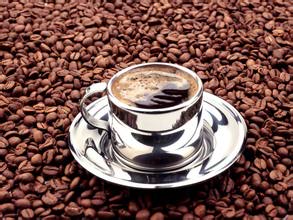Brazilian pectin sun-dried coffee beans-the difference between sun-dried and washed coffee beans
Brazilian pectin sun-dried coffee beans-difference between sun-dried and washed coffee beans
Brazil's vast coffee fields are mostly harvested mechanically for economic reasons. When 75% of the coffee fruit in the coffee garden turns red, the mechanical harvesting is started, followed by the same pre-operation of washing, which is transferred to the sink to remove the floating beans, sifting out the sunk beans, and then using a large pulp sifter to remove the pulp and remove the pods covered with pectin. The next stage is separate from the washing method: instead of moving the sticky pods to a tank for fermentation, they are moved to an outdoor drying field. Due to the dry climate in Brazil, the sticky pectin on the pods hardens in about a day. Then use a lot of manpower to turn up and down, so that the pod evenly dry inside and outside, so as not to regain moisture and stink, about two to three days with the help of sunlight and dry weather natural forces, the pod can reach a certain degree of dehydration. Then further drying in a dryer to reduce the moisture content to 10.5--12%, and then storing the pods in special containers for about ten days, further ripening, in order to stabilize the quality, before export and then grinding off the sheep dust (i.e. pods), take out the coffee beans, graded packaging. Mucous membrane adhesion is very strong, and not easy to remove, must be placed in the tank about 18-36 hours, so that its alcohol, and decomposition of the mucosa. There are two methods of fermentation, wet and dry, as the name suggests, the former with water, the latter without water. During the alcoholization process, the seeds and internal pulp will undergo special changes, which is one of the most influential steps in the water washing method. After washing, the coffee beans are still wrapped in the inner skin. The moisture content reaches 50%. They must be dried to reduce the moisture content to 12%. Otherwise, they will continue to be alcoholized and become moldy. The better treatment is to use sunlight drying, although it takes 1 - 3 weeks, but the flavor is excellent and quite popular. In addition, some places use machine drying, which greatly shortens the processing time and makes the flavor inferior to sun-dried coffee.
Brazil's vast coffee fields are mostly harvested mechanically for economic reasons. When 75% of the coffee fruit in the coffee garden turns red, the mechanical harvesting is started, followed by the same pre-operation of washing, which is transferred to the sink to remove the floating beans, sifting out the sunken beans, and then using a large pulp sifter to remove the pulp and remove the pods covered with pectin. The next stage is separate from the washing method: instead of moving the sticky pods to a tank for fermentation, they are moved to an outdoor drying field. Due to the dry climate in Brazil, the sticky pectin on the pods hardens in about a day. Then use a lot of manpower to turn up and down, so that the pod is evenly dried inside and outside, so as not to regain moisture and stink. In about two to three days, with the help of the natural force of sunshine and dry climate, the pod can reach a certain degree of dehydration. Then further drying in a dryer to reduce the moisture content to 10.5- 12%, storing the pods in special containers for about ten days, further ripening to stabilize the quality, grinding off the sheepskin (i.e. pods) before export, taking out the coffee beans, and packaging them in grades

Important Notice :
前街咖啡 FrontStreet Coffee has moved to new addredd:
FrontStreet Coffee Address: 315,Donghua East Road,GuangZhou
Tel:020 38364473
- Prev

What factors determine the carbohydrate content of coffee
What factors determine the carbohydrate content of coffee Low molecular weight sugars: Sucrose is the most important free sugar in green coffee beans, and its content varies according to variety, source and maturity. Arabica beans generally contain higher amounts of sucrose than Robusta beans; other simple sugars, including reducing sugars, can also be detected in the extract of green coffee beans. Green coffee beans also
- Next

Grinding scale of Sidamo Lion King Coffee Bean introduction to the regional treatment method of variety production
Sidamo Lion King Coffee Bean Grinding scale Coffee Variety Regional treatment method Sidamo Coffee Raw beans are grayish in some places thick and small in some places, soft and strong acidity, mellow and sweet and spicy. It is one of the courtyard coffee in the highlands of southern Ethiopia. Unlike ordinary African coffee, Sidamo has clear acidity, a smooth taste, and a
Related
- Guji coffee producing area of Guji, Ethiopia: Humbela, Shakiso, Wulaga
- What is the most expensive variety of Qiloso in BOP multi-variety group?
- How to store the coffee beans bought home?
- Why are Yemeni coffee beans so rare now?
- Ethiopian Sidamo all Red Fruit Sun Sun Santa Vini Coffee beans
- SOE is mostly sour? What does it mean? Is it a single bean? what's the difference between it and Italian blending?
- Is Italian coffee beans suitable for making hand-brewed coffee?
- How to choose coffee beans when making cold coffee? What kind of coffee beans are suitable for making cold coffee?
- Just entered the pit to make coffee, what kind of coffee beans should be chosen?
- Can only Japan buy real Blue Mountain Coffee? What are authentic Jamaican Blue Mountain coffee beans?

